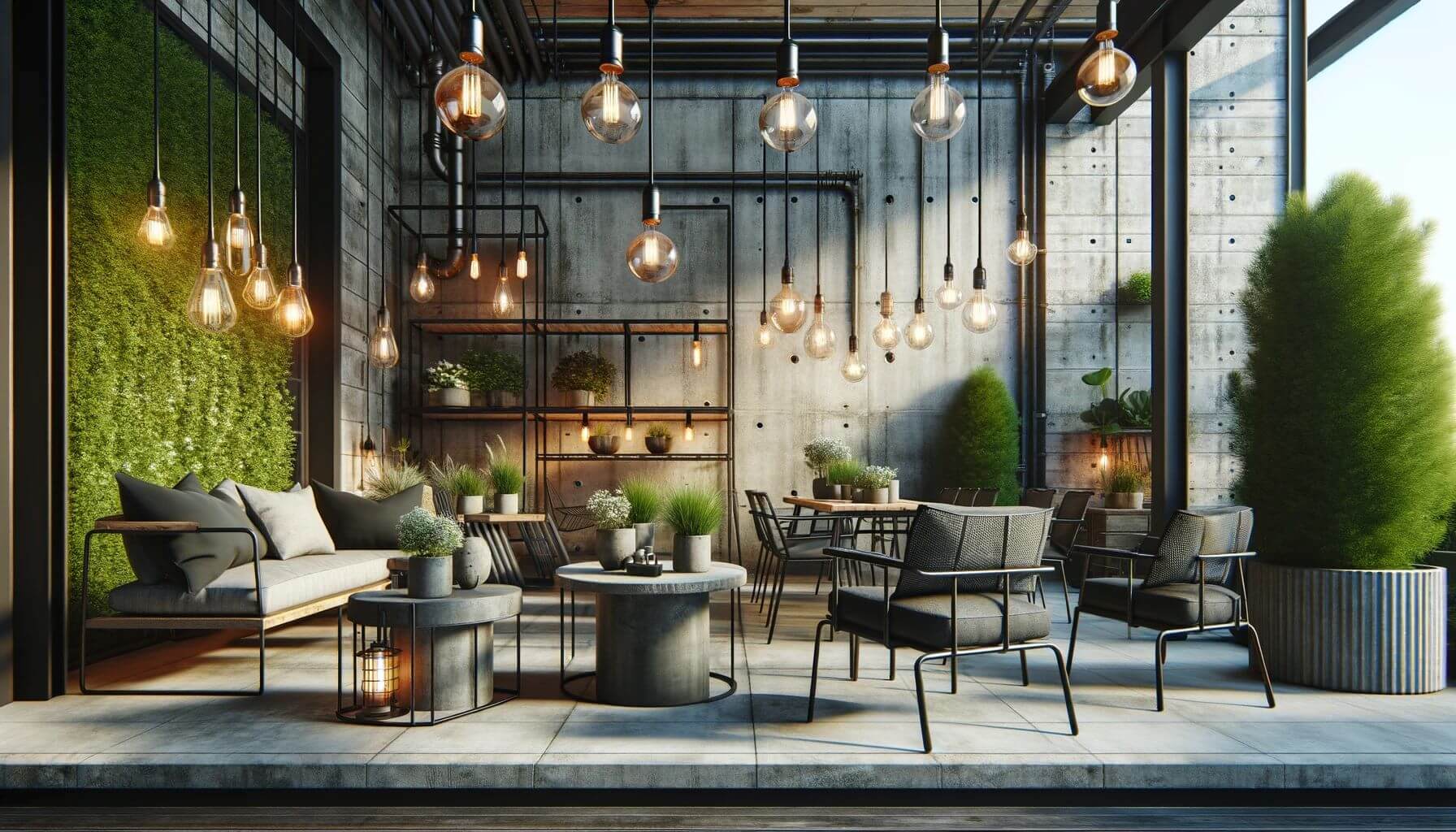
Outdoor spaces are more than just areas outside our homes. They are extensions of our living spaces. Thus, choosing the right furniture is crucial. Weather-resistant outdoor furniture stands at the forefront of this selection. Why? Because it promises durability and longevity under the sun, rain, and more.
Now, let’s explore a fascinating aspect: metallurgy. This ancient science plays a pivotal role in crafting durable outdoor furniture. It’s all about understanding metals and their reactions to environmental conditions. Metallurgy is the backbone of creating pieces that not only last but also maintain their beauty over time.
Understanding the Basics of Metallurgy in Outdoor Furniture
Metallurgy isn’t just for industrial giants. It’s a fundamental element in designing outdoor furniture that withstands the test of time. At its core, metallurgy involves manipulating metals to enhance their properties. This manipulation is key to creating furniture that’s not only strong but also resistant to weather’s wear and tear.
Let’s look at the metals commonly chosen for outdoor furniture: aluminum, wrought iron, and stainless steel. Each brings its unique strengths to the table. Aluminum, lightweight and rust-resistant, is perfect for sleek, modern designs. Wrought iron, with its classic look, offers sturdiness and timeless appeal. Stainless steel, known for its strength, battles corrosion like a champion.
However, several factors impact these metals’ durability and resistance to weather. The environment plays a big role. Saltwater can accelerate corrosion, while UV exposure may weaken coatings. Additionally, the manufacturing process, including alloy composition and protective finishes, can significantly influence a piece’s lifespan.
These basics set the stage for creating outdoor furniture that’s functional and enduring.
The Science Behind Weather Resistance
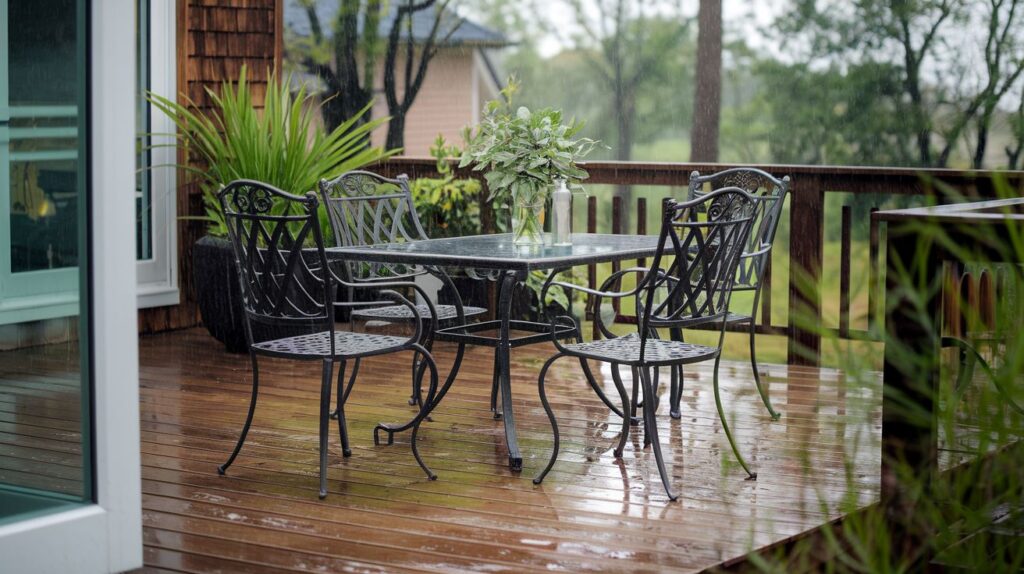
Diving deeper into what makes outdoor furniture last, we encounter two common adversaries: corrosion and rust. Corrosion is the metal’s reaction with environmental elements, leading to deterioration. Rust, a type of corrosion, specifically affects iron and its alloys, leading to the familiar reddish-brown flake.
Why does this matter? Corrosion and rust not only mar the furniture’s appearance but also weaken its structural integrity. Hence, understanding and combating these processes is essential for durable outdoor furniture.
Enter alloys and protective treatments, our primary defense mechanisms. Alloys, created by mixing metals, are designed with weather resistance in mind. For instance, adding chromium to steel creates stainless steel, vastly improving its resistance to rust and corrosion.
Moreover, protective coatings and treatments play a crucial role. Powder coating, a process where powdered paint is electrostatically applied and cured under heat, provides a hard finish that is tougher than conventional paint. Galvanization, another effective treatment, involves applying a protective zinc layer to steel or iron, to prevent rusting.
These strategies are not just about preventing wear and tear. They’re about preserving beauty and functionality, ensuring that outdoor furniture continues to enhance our living spaces, come rain or shine.
Material Spotlight: Advantages and Applications
Each metal used in outdoor furniture comes with its set of benefits, tailored to various design needs and environmental conditions. Let’s explore these materials in detail.
Aluminum
Aluminum stands out for its lightweight nature, making it easy to move and rearrange. Its inherent corrosion resistance is a major plus, especially in humid or coastal environments. This metal suits modern designs well, thanks to its sleek finish and versatility.
In outdoor settings, aluminum is often seen in dining sets, loungers, and decorative pieces. Its low maintenance and durability make it a favorite for both residential and commercial spaces.
Wrought Iron
Wrought iron evokes a sense of classic elegance and timeless beauty. Its heavy-duty nature offers unparalleled stability and sturdiness. However, this material does require a bit of TLC to fend off rust.
Regular inspections for scratches or chips, followed by touch-ups with protective paint, can prolong its life. Additionally, applying a rust-inhibitor every few years helps maintain its integrity. Wrought iron’s ornate designs make it perfect for garden benches, gates, and statement pieces that add character to any outdoor area.
Stainless Steel
For those seeking a blend of durability and minimal maintenance, stainless steel is the go-to. This alloy resists corrosion and rust remarkably well, thanks to the addition of chromium. Stainless steel’s sleek and modern aesthetic fits seamlessly into contemporary outdoor spaces.
It’s ideal for environments prone to inclement weather, offering longevity and ease of care. Stainless steel furniture, ranging from dining sets to sleek loungers, provides a sophisticated touch to patios and poolside areas, matching various design styles with its versatile finish.
In summary, choosing the right material for your outdoor furniture hinges on understanding these metals’ unique properties. Whether you prioritize elegance, modernity, or practicality, there’s a metal option tailored to your outdoor living space.
Technological Advances in Metal Furniture Manufacturing

The landscape of metal outdoor furniture is rapidly evolving, thanks to cutting-edge technological advances. These innovations not only enhance the durability and weather resistance of furniture but also introduce smart functionalities and eco-friendly features. Let’s delve into the forefront of these advancements.
Innovations in Material Engineering
The quest for improved weather resistance has led to significant breakthroughs in material engineering. Alloys are being fine-tuned for greater resilience against corrosion, UV damage, and temperature fluctuations. For instance, new aluminum alloys offer the lightweight nature of traditional aluminum but with enhanced strength and durability, rivaling that of heavier metals.
The Emergence of Smart Coatings and Nano-technologies
Smart coatings and nano-technologies represent a revolution in furniture finishings. These coatings are designed to repel water, resist UV radiation, and minimize the adherence of dirt and pollutants, making furniture maintenance a breeze. Nano-coatings, in particular, can provide a self-cleaning effect, where rainwater washes away dirt particles, keeping furniture looking new with minimal effort.
Future Trends in Metal Outdoor Furniture Manufacturing
Looking ahead, the integration of technology into outdoor furniture is set to increase. We’re beginning to see the incorporation of IoT (Internet of Things) devices into furniture design, enabling features such as weather sensors, solar-powered charging stations, and LED lighting for ambiance and functionality. Additionally, sustainability remains a key focus, with an emphasis on recyclable materials and energy-efficient manufacturing processes.
The future of metal outdoor furniture lies in the seamless blend of form, function, and sustainability. As these technological advancements continue to unfold, they promise to bring about outdoor furniture that’s not only more durable and maintenance-free but also smarter and kinder to our planet.
Sustainability and Eco-Friendly Practices
In the realm of metal outdoor furniture, sustainability and eco-friendly practices are gaining prominence. As consumers become more environmentally conscious, the demand for furniture that aligns with these values increases. Let’s explore how sustainability is being integrated into the design and manufacturing of metal outdoor furniture.
The Role of Recycled Materials
Recycled materials are at the heart of sustainable furniture design. Metals like aluminum and steel are particularly well-suited for recycling without loss of quality. By utilizing recycled metals, manufacturers can significantly reduce the environmental impact associated with mining and processing raw materials. Furniture made from recycled metals not only helps conserve natural resources but also reduces the carbon footprint of production.
Lifespan and Recyclability of Different Metals
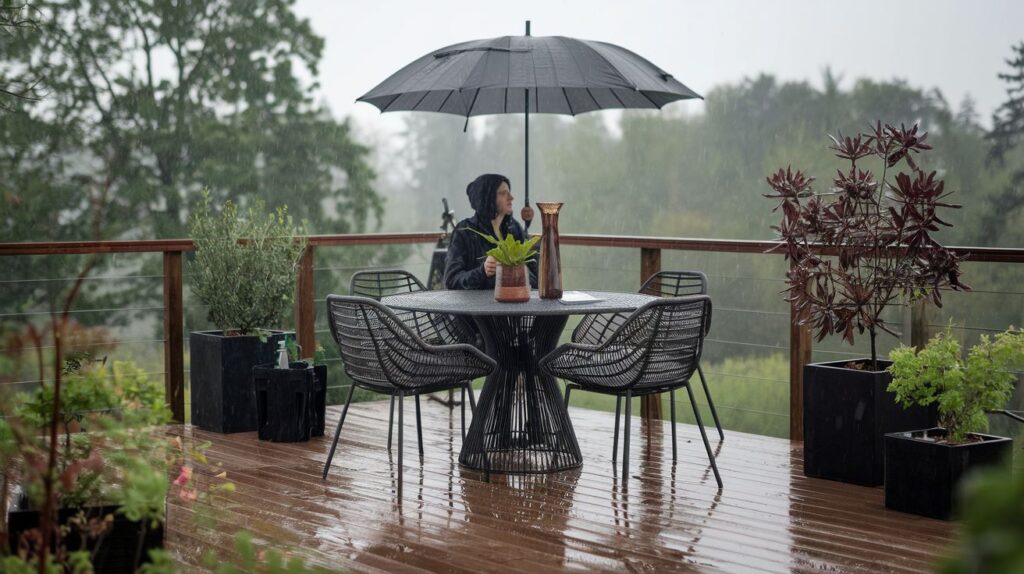
The sustainability of metal furniture also lies in its longevity. Metals such as aluminum, wrought iron, and stainless steel are known for their durability, often outlasting their wooden or plastic counterparts. This extended lifespan means less frequent replacement and, consequently, less waste. Furthermore, when metal furniture does reach the end of its life, its materials can be recycled again, creating a closed-loop system that minimizes waste.
Eco-friendly Manufacturing Processes
Advances in manufacturing processes are also contributing to more sustainable metal furniture. Techniques such as powder coating, mentioned earlier, not only provide a durable finish but do so with less environmental impact than traditional wet painting. Powder coating emits fewer volatile organic compounds (VOCs), making it a more eco-friendly option. Additionally, manufacturers are exploring renewable energy sources and waste reduction methods in production to further lessen the environmental footprint of their products.
The integration of sustainability into the design and manufacturing of metal outdoor furniture not only benefits the environment but also resonates with consumers looking to make responsible choices. As this trend continues, we can expect to see an increase in eco-friendly innovations in the furniture industry, marrying aesthetics with environmental stewardship.
Maintenance and Care for Longevity
Ensuring the longevity of metal outdoor furniture involves regular maintenance and care. Proper upkeep not only preserves the appearance of your furniture but also its functionality and durability. Let’s navigate through the best practices, seasonal care tips, and DIY solutions to keep your metal furnishings in prime condition.
Best Practices for Cleaning and Maintaining Metal Outdoor Furniture
Regular cleaning is paramount. Start with mild soap and water to remove dirt and grime. For aluminum pieces, a soft cloth will suffice to prevent scratching the surface. Stainless steel and wrought iron may require a more robust approach, such as a soft-bristled brush, to tackle tougher spots without damaging the finish.
After cleaning, thoroughly dry your furniture to prevent water spots and potential rust on susceptible metals. Applying a protective wax or sealant, specifically designed for the type of metal, can add an extra layer of protection against the elements.
Seasonal Care Tips to Enhance Weather Resistance
Seasonal changes demand specific care strategies. Before winter, it’s wise to apply a fresh coat of protective finish, whether it’s a specialized paint for wrought iron or a clear lacquer for aluminum and stainless steel. If possible, store furniture indoors or cover it with water-resistant covers to shield it from snow and rain.
In preparation for spring and summer, inspect your furniture for any signs of wear or damage. Early detection of rust spots, particularly on wrought iron, allows for prompt treatment with a rust inhibitor followed by touch-up paint. This not only keeps your furniture looking great but also extends its lifespan.
DIY Solutions for Common Issues Like Rust and Wear
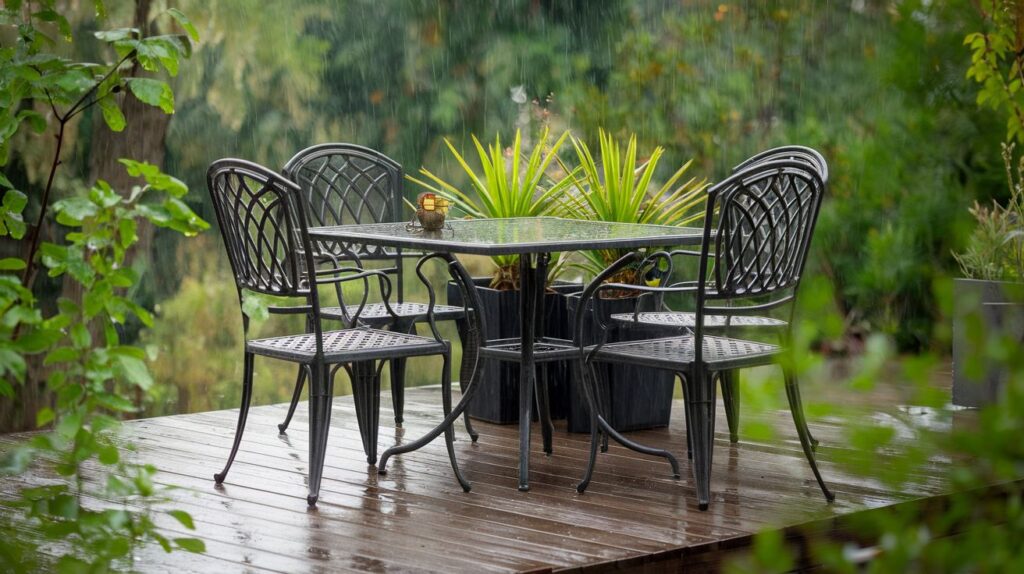
Encountering rust or wear on your metal furniture isn’t a cause for despair. For minor rust, sanding the affected area gently with fine-grit sandpaper, followed by applying a rust-converting primer and touch-up paint, can effectively mitigate the issue. This DIY fix restores the protective barrier against further corrosion.
For scratches or wear in the finish, auto touch-up paints or a matching outdoor metal paint can be used to seamlessly cover blemishes, ensuring the furniture continues to resist the elements effectively.
Adhering to these maintenance and care practices not only keeps your metal outdoor furniture looking its best but also significantly contributes to its longevity, allowing you to enjoy your outdoor spaces for many seasons to come.
Choosing the Right Weather-Resistant Furniture for Your Space
Selecting the perfect weather-resistant furniture involves more than just an appreciation for aesthetics; it requires a thoughtful consideration of various factors to ensure your outdoor space remains beautiful and functional for years. Let’s explore what to keep in mind when making your selection.
Factors to Consider
- Climate: The climate of your area plays a crucial role. Salty, coastal air demands corrosion-resistant materials like powder-coated aluminum or stainless steel. Areas with high moisture levels or frequent rain require furniture that can withstand rust, such as galvanized or stainless steel.
- Design Preferences: Your outdoor furniture should reflect the style and vibe of your home. Whether you lean towards the modern and sleek or the classic and ornate, ensure the materials align with your design ethos.
- Maintenance Willingness: Consider how much time and effort you’re willing to invest in maintenance. Aluminum offers ease with minimal upkeep, while wrought iron might need more attention to prevent rust and maintain its appearance.
Comparative Analysis of Metal Types for Different Environmental Conditions
- Aluminum is the all-rounder, resistant to rust and corrosion, making it suitable for almost any climate. Its lightweight nature makes it easy to move and store, ideal for versatile outdoor layouts.
- Wrought Iron, with its heavyweight and sturdy frame, stands up well to windy conditions but requires regular maintenance to keep rust at bay. It’s perfect for traditional designs and those looking for furniture with a weighty presence.
- Stainless Steel combines the best of both worlds with its high resistance to corrosion and substantial feel. However, it’s particularly suited for areas not exposed to chlorinated water or coastal air, unless specifically treated for such conditions.
Tips for Selecting Weather-Resistant Accessories and Complements
- Look for cushions and pillows with water-resistant or waterproof fabrics to enhance the comfort of your metal furniture without worrying about damage from moisture.
- Consider umbrellas, pergolas, or awnings made with UV-resistant materials to provide shade and protect both your furniture and your skin from the sun’s harsh rays.
- Opt for outdoor rugs made from synthetic fibers like polypropylene, which are not only durable and fade-resistant but also provide a cozy underfoot and help define the seating area.
Choosing the right weather-resistant furniture and accessories for your outdoor space is a balancing act of aesthetics, functionality, and practicality. By considering these factors, you can create an inviting and enduring outdoor living area that you and your guests will enjoy throughout the changing seasons.
The Future of Outdoor Metal Furniture

The horizon for outdoor metal furniture is bright and brimming with innovation. As we look ahead, emerging materials and technologies are set to redefine durability, aesthetics, and eco-friendliness. Concurrently, evolving design trends are guiding the development of furniture that meets the demands of modern outdoor living spaces. Let’s delve into what the future holds.
Emerging Materials and Technologies
- Advanced Alloys: The search for materials that can endure harsh weather conditions with minimal maintenance is leading to the creation of new alloys. These materials promise enhanced strength and corrosion resistance, expanding the possibilities for outdoor furniture design.
- Smart Furniture Technologies: Imagine outdoor furniture that can charge your devices, light up your garden at night, or even adjust its form for comfort based on temperature and sunlight. These are not far-off dreams but realities on the cusp of entering the market, thanks to advancements in IoT and smart materials.
- Eco-Friendly Innovations: As sustainability becomes increasingly important, materials made from recycled plastics and metals are gaining traction. These not only reduce waste but also offer resistance to weathering, fading, and rusting, aligning durability with environmental responsibility.
Weather-Resistant Metal Outdoor Furniture Design Trends
- Blending Indoors with Outdoors: Furniture that effortlessly transitions between indoor and outdoor spaces is becoming a staple in modern design. This trend emphasizes seamless integration, with materials and styles that complement both environments while standing up to the rigors of outdoor use.
- Minimalism and Functionality: Clean lines, minimalistic designs, and multifunctional features are shaping the future of outdoor furniture. This approach caters to the growing desire for uncluttered spaces that are both stylish and practical, encouraging a focus on quality and sustainability.
- Personalization and Flexibility: Customizable and modular furniture options are on the rise, offering the ability to personalize outdoor spaces to individual tastes and needs. This flexibility ensures that outdoor living areas can evolve without the need for complete overhauls, supporting sustainability through adaptable design.
As we move forward, the future of outdoor metal furniture is set to offer more than just places to sit and dine. It promises to enhance our connection with the outdoors through innovative materials and technologies, thoughtful design, and a deepened commitment to sustainability. The evolution of outdoor furniture is not just about adapting to the environment but also about enriching our outdoor living experience in harmony with nature.
Weather-Resistant Metal Outdoor Furniture Tips
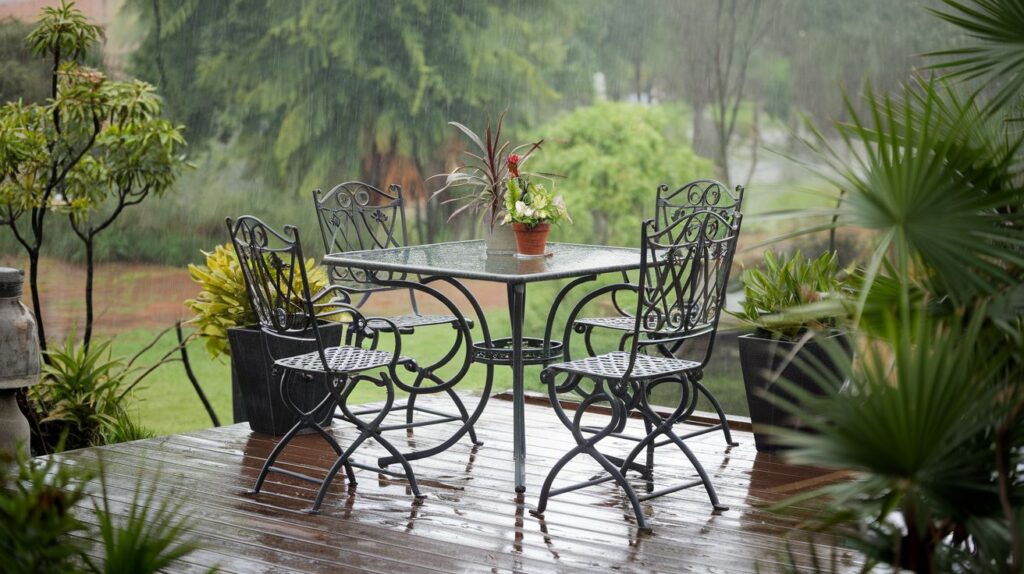
Outdoor metal furniture underscores the pivotal role metallurgy plays in crafting pieces that withstand the elements. From the basics of metal types and their inherent properties to the cutting-edge technologies and trends shaping the future, it’s clear that selecting outdoor furniture is both an art and a science.
Understanding the metallurgical secrets behind each piece allows us to appreciate not just the functionality but also the beauty they bring to our outdoor spaces. As we move forward, let’s embrace the blend of aesthetics and durability, ensuring our outdoor areas are as inviting as they are enduring.
FAQ on Weather-Resistant Metal Outdoor Furniture
- What makes metal furniture weather-resistant?
Weather resistance in metal furniture is achieved through the choice of material (like aluminum, wrought iron, or stainless steel), protective coatings (such as powder coating and galvanization), and innovative treatments that enhance durability against rust, corrosion, and UV damage. - How do different metals compare in terms of durability and maintenance?
Aluminum is lightweight, corrosion-resistant, and requires minimal maintenance, making it ideal for various climates. Wrought iron is sturdy and classic but requires regular care to prevent rust. Stainless steel offers a balance of durability and ease of maintenance, resisting corrosion and rust effectively with minimal upkeep. - Can weather-resistant metal furniture be eco-friendly?
Yes, eco-friendliness can be a key feature of weather-resistant metal furniture, especially when manufacturers utilize recycled materials, employ sustainable manufacturing processes, and design products with long life spans to reduce environmental impact. - How often should metal outdoor furniture be maintained?
The frequency of maintenance depends on the material and environmental conditions. Generally, cleaning a few times a year and applying protective treatments as needed (annually for some metals) can keep furniture in good condition. Inspect regularly for signs of wear or damage, especially after harsh weather. - Are there new technologies improving metal furniture’s weather resistance?
Yes, advancements in material engineering, such as new alloys and smart coatings, along with nano-technologies, are enhancing the weather resistance of metal furniture. These innovations offer improved durability, reduced maintenance needs, and added functionalities like self-cleaning surfaces and integrated technology features.



